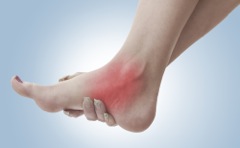Known as chronic lateral ankle pain, the recurring or chronic pain you feel on the outer side of the ankle often develops after an injury such as a sprain. However, several other conditions may also cause chronic ankle pain.
What are the symptoms of chronic lateral ankle pain?
- Pain, usually on the outer side of the ankle, may be so intense that you have difficulty walking or participating in sports. In some cases, the pain is a constant, dull ache.
- Difficulty walking on uneven ground or in high heels
- A feeling of giving way (instability)
- Swelling
- Stiffness
- Tenderness
- Repeated ankle sprains
What causes chronic lateral ankle pain?
According to Th e American Orthopaedic Foot & Ankle Society, the most common cause for a persistently painful ankle is incomplete healing after an ankle sprain. When you sprain your ankle, the connecting tissue between the bones is stretched or torn. Without thorough and complete rehabilitation, the ligament or surrounding muscles may remain weak, resulting in recurrent instability. As a result, you may experience additional ankle injuries.
e American Orthopaedic Foot & Ankle Society, the most common cause for a persistently painful ankle is incomplete healing after an ankle sprain. When you sprain your ankle, the connecting tissue between the bones is stretched or torn. Without thorough and complete rehabilitation, the ligament or surrounding muscles may remain weak, resulting in recurrent instability. As a result, you may experience additional ankle injuries.
Other causes of chronic ankle pain include:
- An injury to the nerves that pass through the ankle. (The nerves may be stretched, torn, injured by a direct blow or pinched under pressure, known as “entrapment.”
- A torn or inflamed tendon
- Arthritis of the ankle joint
- A fracture in one of the bones that make up the ankle joint
- An inflammation of the joint lining, called “synovium.”
- The development of scar tissue in the ankle after a sprain. The scar tissue takes up space in the joint, thus putting pressure on the ligaments.
How is chronic lateral ankle pain diagnosed?
The first step in identifying the cause of chronic ankle pain is taking a history of the condition. Your health care provider may ask you several questions, including:
- Have you previously injured the ankle? If so, when?
- What kind of treatment did you receive for the injury?
- How long have you had the pain?
- Are there times when the pain worsens or disappears?
Because there are so many potential causes for chronic ankle pain, your health care prodider may need to conduct several tests to pinpoint the diagnosis, beginning with a physical examination. S/he may feel for tender areas and look for signs of swelling, and may have you move your foot and ankle to assess range of motion and flexibility. Your provider may also test the sensation of the nerves, and may administer a shot of local anesthetic to help pinpoint the source of the symptoms.
Your health care provider may also order X-ray views of your ankle joint. If needed, you may also need to get X-rays of the other ankle so the doctor can compare the injured and non-injured ankles. In rare cases, additional tests such as a bone scan, computed tomography (CT) scan or magnetic resonance image (MRI) may be needed.
What are treatment options?
Treatment will depend on the final diagnosis and will be personalized to your individual needs. Both non-operative and surgical treatment methods may be used.
Some conservative treatments include:
- Anti-inflammatory medications such as aspirin or ibuprofen to reduce swelling
- Physical therapy, including tilt-board exercises, directed at strengthening the muscles, restoring range of motion and increasing your perception of joint position
- An ankle brace or other support
- An injection of a steroid medication
- In the case of a fracture, immobilization to allow the bone to heal
If your condition requires it, or if conservative treatment doesn’t bring relief, your doctor may recommend surgery. Many surgical procedures can be done on an outpatient basis. Some procedures use arthroscopic techniques; other require open surgery. Rehabilitation may take six to 10 weeks to ensure proper healing. Surgical treatment options include:
- Removing (excising) loose fragments
- Cleaning (debriding) the joint or joint surface
- Repairing or reconstructing the ligaments or transferring tendons
Prevention
Almost half of all people who sprain their ankle once will experience additional ankle sprains and chronic pain. You can help prevent chronic pain from developing by following these simple steps:
- Follow your doctor’s instructions carefully and complete the prescribed physical rehabilitation program.
- Do not return to activity until cleared by your physician.
- When you do return to sports, use an ankle brace rather than taping the ankle. Bracing is more effective than taping in preventing ankle sprains.
- If you wear high-top shoes, be sure to lace them properly and completely.
